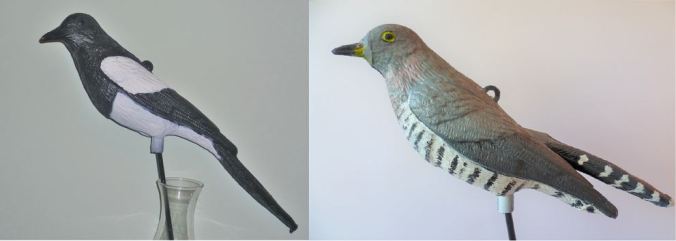 During the years with my former trainers, I used to ring regularly throughout the breeding season at several sites on Dartmoor where Cuckoos were often present. To increase our changes of trapping these difficult birds, I set about making a series of lures using plastic Magpie decoys. In the end I produced three, a male, a female and a hepatic female, which covered all the options and proved reasonably successful in attracting the birds to the netting areas, when used together with a tape. When I changed trainers at the start of 2017, I left the decoys behind, as it has been some years since Cuckoos last parasitized Reed Warblers in Devon’s reedbeds and they would have been little use to me at South Milton.
During the years with my former trainers, I used to ring regularly throughout the breeding season at several sites on Dartmoor where Cuckoos were often present. To increase our changes of trapping these difficult birds, I set about making a series of lures using plastic Magpie decoys. In the end I produced three, a male, a female and a hepatic female, which covered all the options and proved reasonably successful in attracting the birds to the netting areas, when used together with a tape. When I changed trainers at the start of 2017, I left the decoys behind, as it has been some years since Cuckoos last parasitized Reed Warblers in Devon’s reedbeds and they would have been little use to me at South Milton.
When we returned from Crete, I received an email from a colleague, who operates a CES on Goss Moor in Cornwall, asking to borrow a decoy. Unfortunately, I couldn’t help but I’ve just had a skin cancer removed from my face and although the area affected was relatively small it’s left a big hole, which needed sixteen stitches to patch it up. Consequently, I’m not allowed to do much as the surgeon has forbidden me from ringing until the stitches come out in a week’s time. Apparently, she considers the mud, stagnant water, sewage outfall and rat and bird faeces at South Milton to be an infection risk! Anyway, to keep things brief, I used the time to make a new decoy – a standard female. Let’s hope it proves effective!

Before and after

